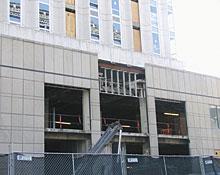The answer was no, it shouldn't be used during construction. Most of the talk centered on why.
"Back when I was doing new construction, we had the HVAC installed and then sheet rock," recalled one forum participant (whose anonymity is secured by ASHRAE's forum rules). "The filters for construction were to be changed before the building's occupancy. The filters needed to be replaced a lot more frequently during construction," he concluded. Sheet rock dust coated the HVAC system's coils before the building was even occupied.
One concern, said an engineer, is that filters won't be 100 percent effective in protecting the permanent system. Dust and debris can easily become food for microbial growth once coils get wet. The system would need to be cleaned prior to occupancy.
"A prominent engineer has pointed out that sheet rock is particularly problematic," said a humidity expert. "They [sheet rock installers] want low humidity for curing. When moisture comes into the dehumidification coil, it turns to concrete."

Temporary Solutions
Temporary systems are available that have been designed for construction applications. "You don't have to use the permanent system unless you are cheap and don't mind ruining your equipment," said a forum participant.Another participant presented the owner's side and parameters that may restrict the use of temporary heating-cooling systems: the size of the facility, type of equipment, and season in which work is being performed. "Our specs say temporary heating will be provided by the contractor and taken out when construction is over," he said. Heating is provided for workers' comfort and equipment freeze protection.
Several HVAC associations have plans to issue guidelines and bulletins warning against the use of the permanent system during construction.
One engineer asked how you define what a temporary system is. When construction is occurring on a partially finished building, or space is being added to an existing facility, "that line can get fuzzy," he said. Guidelines also need to help owners identify who should bear the cost of providing the temporary system. Asking the contractor to cover it "is not fair to contractors," he said.
A utility representative pondered whether better filtration during construction could help solve problems associated with using the permanent HVAC system. "You could use HEPA- or bag-type filters," an engineer replied, "but when you've got the drywaller there, there will be dust loading and pressure drop." Filters would need to be changed much more often during construction, and someone would need to be in charge of doing that. If they didn't, the permanent system could still be damaged.
Salamander heaters are a frequently used temporary solution, though fumes may be a concern. Fabric ductwork and temporary plastic duct may also be used for temporary solutions.
Another participant wondered whether the permanent system would even be the right size to heat and cool during construction, when the structure has no windows and no doors.
"How far finished is a building's HVAC systems if the building has no windows?" countered another engineer. It was agreed that this discussion, at least, should be focused on the build-out period of a construction project, when interior materials are installed.
More sophisticated HVAC systems probably would not be hooked up to the controls during the build-out phase. "They would be hand operated, which is very risky to the system," a participant pointed out.
When a permanent system is operated during construction, "What are you doing to the manufacturer's warranty?" asked an engineer. The warranty period typically begins when the system is started up.
Some respected engineers have advised manufacturers not to warranty their systems for use during construction. However, "It is almost indefensible for manufacturers to withhold a warranty," said an equipment manufacturer. "Manufacturers are still held liable."
It's important to get information on cost benefits of not using permanent systems during construction, he continued. "It is an issue that weighs on us all, residential too, and we can't stop our contractors from using the permanent systems."
Publication date: 08/08/2005



